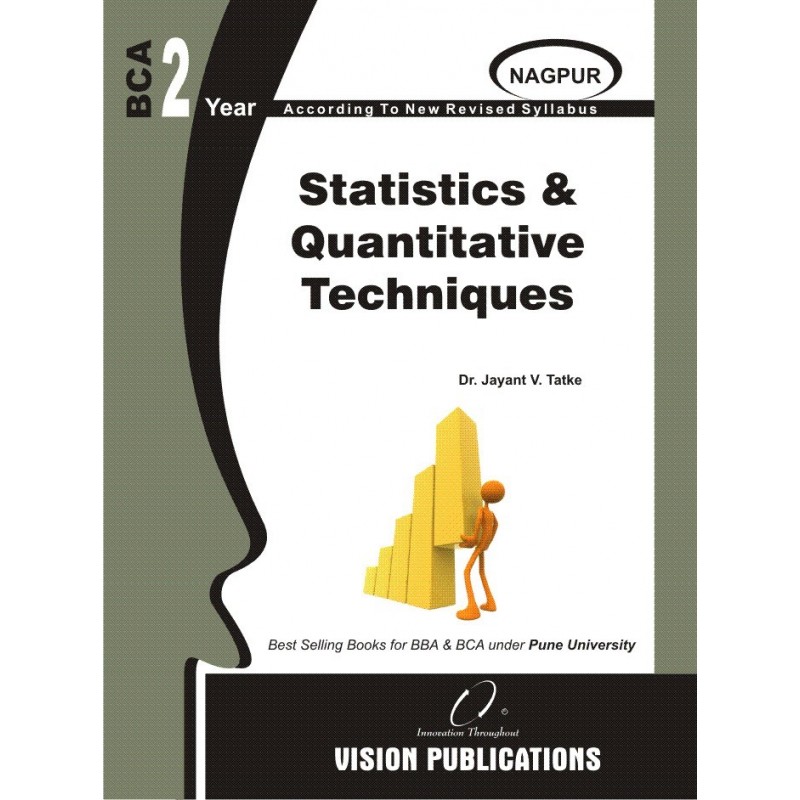Email: tovisionpune@gmail.com



According to New Revised Syllabus w.e.f. 2009 Nagpur, Maharashtra (INDIA)
SY BCA (Nagpur)
Author : Dr. J.V. Tatke
Book ID : 1136
Contents
1. Introduction
1.1 Introduction
1.2 What is statistics?
1.3 Definition of statistics
1.4 Statistic and statistics
1.5 Statistics: Science or art
1.6 Characteristics of statistics
1.7 Functions of statistics
1.8 Limitations of statistics
1.9 Misuse and distrust of statistics
1.10 Scope (Or Application) of statistics
1.11 Subdivisions within statistics
2. Some Statistical Concepts and Terms
2.1 Statistical terms
2.2 Statistical concepts
3. Data Collection
3.1 Introduction
3.2 Type of data
3.3 Sources of data
3.4 Measurement scales
3.5 Procedures for collecting data
3.6 Sampling and non-sampling errors
3.7 Methods of data collection
3.8 Data collection tools
3.9 Questionnaire and schedules
3.10 Designing a questionnaire
3.11 Errors in measurement
4. Presentation of Data
4.1 Introduction
4.2 Editing of data
4.3 Coding of data
4.4 Classification of data
4.5 Tabulation of data
4.6 Frequency distribution
4.7 Constructing a frequency distribution
4.8 Cumulative frequency distribution
4.9 Graphical frequency distributions
4.10 Ogive curve
4.11 Graphic presentation
5. Analysis of Data Measures of Central Tendency
5.1 Introduction
5.2 Measures of central tendency
5.3 Advantages and disadvantages of A.M., G.M. and H.M.
5.4 Advantages and disadvantages of median
5.5 Advantages and disadvantages of mode
5.6 Comparing the mean, median, and mode
5.7 Relation between A.M., G.M. and H.M.
5.8 Quartiles, deciles and percentiles
6. Analysis of Data Measures of Dispersion
6.1 Introduction
6.2 Measures of dispersion
6.3 Absolute measures
6.4 Relative measures of dispersion
6.5 Measures of skewness
6.6 Lorenz curve
7. Correlation
7.1 Introduction
7.2 Correlation
7.3 Types of relationships
7.4 Types of correlation
7.5 Methods of correlation
7.6 Uses of correlation
7.7 Interpretation of correlation coefficient
7.8 Properties of correlation coefficient
7.9 Spearmans rank correlation
7.11 Probable error of correlation coefficient
7.12 Coefficient of determination
7.13 Practical application of correlations
8. Linear Regression
8.1 Introduction
8.2 Regression
8.3 Regression equations
8.4 Linear regression
8.5 Fitting of a straight line
8.6 Regression coefficients
8.7 Difference between correlation and regression
8.8 Some important points about regression
8.9 Limitations of regressions
9. Index Number
9.1 Introduction
9.2 Definition and nature of index numbers
9.3 Types of index numbers
9.4 Selection of base
9.5 Methods of construction of index numbers
9.6 Construction of index numbers
10. Simple and Compound Interest
10.1 Simple interest
10.2 Formula to find simple interest
10.3 Compound interest
10.4 Formula to find compound interest
10.5 Compound interest applications
11. Annuities
11.1 Introduction
11.2 Annuity
11.3 Present or capital value
11.4 Amount of ordinary annuity
11.5 Present value of an annuity
11.6 Amortization
11.7 Present value concept of capital expenditure
11.8 Present value concept in leasing
11.9 Present value concept of bonds
12. Quantitative Techniques
12.1 Introduction
12.2 Management and decision making
12.3 Meaning of quantitative techniques
12.4 Classification of quantitative techniques
12.5 Various statistical methods
12.6 Various programming techniques
12.7 Limitations of quantitative techniques
12.8 Quantitative techniques and their fields of application
12.9 Manager and quantitative technique specialist
12.10 Role of quantitative techniques